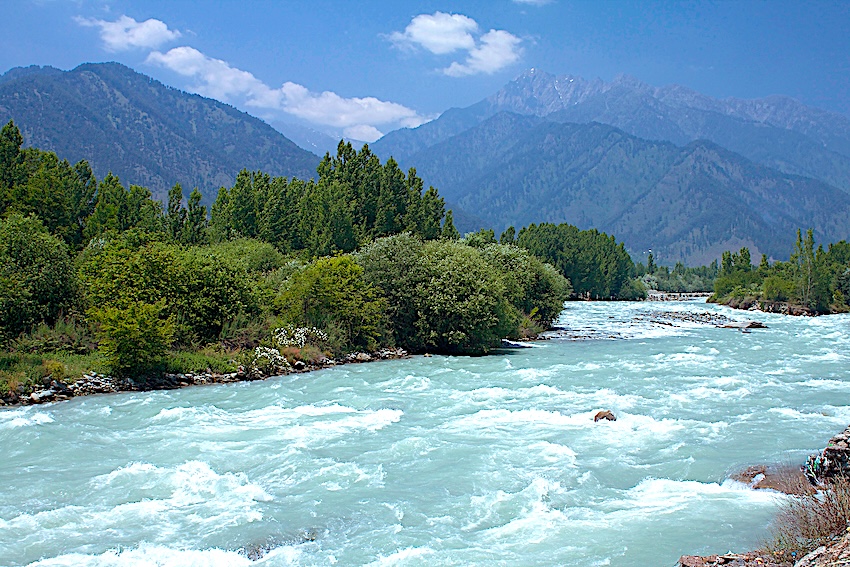Martial Arts
Martial arts are physical, mental, and
sometimes spiritual practices that encompass a wide range of
combat, defense, and energy management techniques. These
disciplines are present in almost all cultures around the world
and vary based on local traditions.
Martial arts are deeply connected to the cultures and traditions
of the societies in which they are practiced. In India, for
example, they are often seen as a means to achieve balance between
the body and mind, acquire survival skills, and maintain good
mental and physical health.
India
Around the 3rd century BCE, Southern India was
divided into several kingdoms, each with its own traditions and
practices. Despite this division, there were strong cultural and
commercial links, particularly between Kerala and Tamil Nadu,
which facilitated the exchange of knowledge and development in
various fields, including martial traditions.
Tamil Nadu was ruled by powerful kingdoms such as the Chola,
Pandya, and Chera dynasties. These kingdoms were known for their
cultural richness, military strength, and trade networks extending
to the Roman Empire, Sri Lanka, and Southeast Asia. The region
flourished economically and culturally, with a strong focus on
warfare and military training, laying the foundation for the
development of martial traditions.
Kerala was influenced by the Chera dynasty, which ruled over the
region. Kerala had strong maritime trade links with the Roman
Empire, Sri Lanka, and the Arabian Peninsula. The region’s
strategic location and cultural exchanges played a key role in
shaping its military traditions, including the development of
martial arts.
Kerala and Tamil Nadu were relatively
independent kingdoms, but they had strong cultural and commercial
exchanges between them. These interactions helped spread martial
arts practices between the two regions.
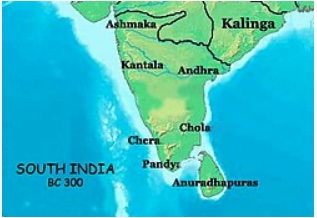
Kalaripayattu, originating from southern
India—particularly Kerala and Tamil Nadu—is considered the first
known martial art in the world. Believed to have developed over
3,000 years ago, it is widely recognized as one of the oldest and
most systematic martial arts still practiced today. Though the
exact date of its inception remains debated, references to it
appear in ancient texts such as the Dhanurveda, part of the Vedic
literature on military science.

Additionally, Kalaripayattu is believed to have influenced other
martial arts such as Kung Fu and Karate. Historical exchanges
between India and China, as well as cultural diffusion along trade
routes, contributed to the spread of martial techniques and
philosophies, with elements of Kalaripayattu likely inspiring the
development of these East Asian martial arts. While the exact
nature of this influence is debated, many elements of
Kalaripayattu, such as its focus on agility, strikes, and the use
of vital points, can be traced in the movements of these martial
arts.
Varma Kalai, an ancient martial
art originating from Tamil Nadu, just south of Kerala, around the
3rd century BCE, is centered around the knowledge and precise
application of vital points (marma). Deeply rooted in Tamil
culture and tradition, it focuses on the art of striking vital
areas of the body for self-defense, healing, and combat
efficiency. Considered one of the oldest and most sophisticated
martial systems of the Indian subcontinent, Varma Kalai played an
important role in the development of martial techniques and
strategies, emphasizing the use of precise strikes on vital areas
for both defense and healing.
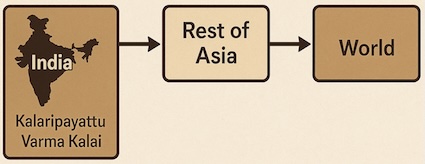
Kalaripayattu & Varma Kalai: Interwoven
Martial Traditions
Shared Techniques: Both arts incorporate the
study and application of vital points or marma. In Kalaripayattu,
these are known as "Varmam" and are integral to advanced training
stages.
Training Overlap: Varma Kalai is often taught in the advanced
stages of Kalaripayattu, Silambam, and Adimurai, indicating a
historical and practical connection between these disciplines.
Kalaripayattu
Kalaripayattu is a comprehensive martial art
that combines physical conditioning, combat techniques, and
spiritual practices. The training is structured into several key
components, each targeting a different aspect of the martial art.
These components are designed not only to build strength and
flexibility but also to develop mental discipline and spiritual
balance.
Meipayattu, meaning "body exercises," forms the foundation of
Kalaripayattu training. This part of the training focuses on
physical conditioning, enhancing strength, flexibility, agility,
and balance. It includes a series of dynamic movements designed to
prepare the body for combat by increasing muscular endurance and
joint flexibility. Through these exercises, practitioners improve
their ability to move fluidly, with grace and speed, which is
crucial for both offensive and defensive techniques.
Verumkai, or bare-handed techniques, form the core of unarmed
combat training in Kalaripayattu. These techniques include various
strikes, kicks, blocks, and evasive movements that allow the
practitioner to defend and attack with their body alone. The
movements in Verumkai are typically swift, precise, and executed
with both power and finesse. The practice of Verumkai also
emphasizes using the whole body in combat, making every part of
the body—hands, feet, elbows, knees, and even the head—a potential
weapon.
Kettukari refers to staff fighting, one of the most important
weapons-based techniques in Kalaripayattu. In this practice,
practitioners learn to fight with a wooden staff, utilizing both
offensive and defensive maneuvers. The staff is a versatile weapon
that allows for a variety of strikes, blocks, and thrusts, and is
used to teach the principles of timing, distance, and rhythm. The
movements in Kettukari are fluid and require precise control, as
the practitioner must coordinate their footwork and staff
movements in a harmonious flow.
Sword and shield combat is another crucial aspect of
Kalaripayattu, where practitioners learn to wield both weapons
simultaneously. The sword (or cheruval in Tamil) is used for
slicing and thrusting attacks, while the shield (or kavacham) is
used for defense, blocking incoming strikes. This technique
requires coordination, timing, and quick reflexes, as the
practitioner must use both weapons in tandem for both offense and
defense. Sword and shield combat in Kalaripayattu emphasizes
agility, precision, and fluidity, with a focus on movement and
strategic positioning.
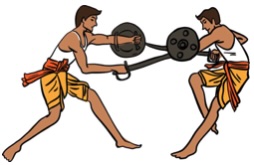
A distinctive feature of Kalaripayattu is the use of
animal-inspired movements. These movements are designed to mimic
the actions and strategies of different animals, such as the lion,
snake, elephant, and tiger. Each animal style embodies a different
aspect of combat, such as speed, power, agility, or strength. For
example, the "lion" stance emphasizes strength and dominance,
while the "snake" movement focuses on fluidity and precision.
These animal forms help develop a deeper understanding of movement
and combat strategies, encouraging the practitioner to adapt to
different situations and opponents.
In addition to combat techniques, Kalaripayattu also incorporates
healing practices. The art includes an understanding of marma, or
vital points on the body, which can be targeted in both combat and
healing. Practitioners learn to identify and treat injuries to
these vital points, using pressure and other techniques to
alleviate pain or restore energy. The healing aspect of
Kalaripayattu makes it unique, as it not only teaches methods of
attack but also offers methods for recovery and self-care.
Meditation and breath control, or pranayama, are integral parts of
Kalaripayattu training. Meditation is used to enhance focus,
clarity, and inner peace, allowing the practitioner to maintain a
calm and controlled mind during both practice and combat. Breath
control exercises help regulate energy flow within the body,
ensuring that movements are executed with maximum efficiency and
minimal fatigue. By controlling their breath, practitioners can
also improve their endurance and mental resilience, which are
essential during long training sessions or real-life
confrontations.
Unique for its combination of martial combat and healing, using
principles of Ayurveda and marma (vital points). It promotes
physical agility, mental focus, and inner energy control.
Kalaripayattu, an ancient martial art from Kerala, is deeply
rooted in Hindu mythology. According to legend, the god Shiva,
known as the god of destruction and dance, is credited with
creating the martial art. Shiva taught it to Parashurama, one of
his avatars, who then passed it on to the people of Kerala,
believing it would help protect the land. The term "Kalaripayattu"
is derived from "Kalari" (battlefield) and "Payattu" (combat),
symbolizing a discipline that integrates both physical combat and
spiritual balance.
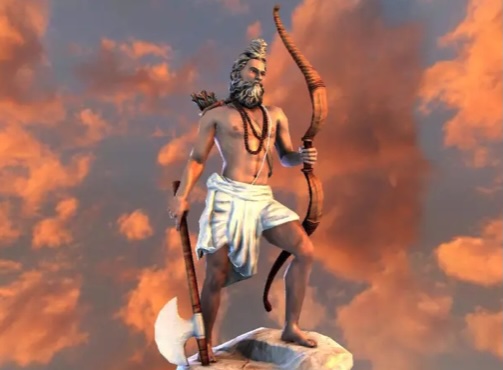
Kalaripayattu was passed down through the guru-shishya tradition
in dedicated kalaris (training halls). Although the art was
suppressed during colonial times, it was revived in the 20th
century and is now practiced both in India and internationally.
Kalaripayattu is said to have influenced martial arts like Kung Fu
through early cultural exchanges. Today, it is practiced for
self-defense, performance, wellness, and cultural heritage.
Varma Kalai
Varma Kalai is a martial art that revolves
around the precise and targeted manipulation of vital points,
known as marma, on the human body. These vital points are believed
to govern the flow of energy (prana) and the overall health of the
body. By understanding and applying techniques to these points,
practitioners can disable an opponent or, conversely, heal
injuries. The martial art involves a combination of offensive and
therapeutic techniques that go beyond simple combat, incorporating
aspects of energy regulation, pressure strikes, and even
traditional healing methods.
The core of Varma Kalai revolves around the concept of marma, the
vital points located throughout the body. These points are seen as
intersections where energy flows, and disrupting or activating
them can have profound effects on both health and combat
performance. In combat, striking these points can disable or
incapacitate an opponent. In healing, manipulating these points
can restore energy flow, reduce pain, or promote physical
recovery. A deep understanding of marma allows practitioners to
both harm and heal with precision.
One of the primary techniques used in Varma Kalai is pressure
strikes, where practitioners apply focused pressure on specific
vital points. These strikes can cause temporary paralysis, pain,
or immobilization by disrupting the energy flow or stimulating the
nervous system. Pressure strikes are often used in self-defense
situations to disable an opponent without causing permanent harm.
Nerve control is another key technique, where the practitioner
manipulates the nervous system through precise touches or strikes,
causing a temporary loss of strength or movement in certain parts
of the body.
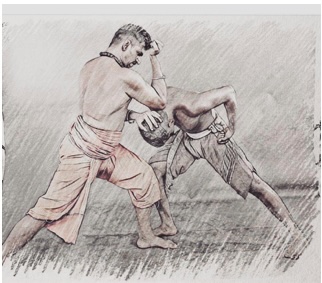
In Varma Kalai, the concept of energy flow regulation (or prana
management) is essential. Practitioners learn to manipulate energy
within their own body and within the bodies of others. By applying
specific techniques to the vital points, they can either block or
enhance the flow of energy, leading to better physical performance
or recovery. In combat, this regulation of energy can be used to
disarm or neutralize an opponent by altering their energy balance,
while in healing, it promotes wellness and pain relief.
The practice of Varma Kalai is a unique blend of both martial
combat and healing techniques. While combat is a significant part
of the tradition, healing is equally important. Practitioners are
trained to recognize the therapeutic potential of the art,
learning how to restore health and vitality after an altercation.
This holistic approach—combining striking, pressure application,
energy manipulation, and healing practices—sets Varma Kalai apart
from other martial systems, emphasizing that martial arts is not
just about physical combat but also about the preservation and
restoration of health.
Varma Kalai is unique for its dual nature: it can both
incapacitate and heal. It requires deep anatomical knowledge and
is traditionally taught only to advanced and morally responsible
students due to its potential danger.
Passed down orally and in secrecy from gurus to chosen disciples.
It remains less public than other martial arts and is often taught
alongside Siddha medicine, a traditional Tamil healing system.
Varma Kalai, originating from Tamil Nadu, is associated with
Muruga, the god of war and martial knowledge, and the son of Shiva
and Parvati. According to tradition, Muruga taught this martial
art, which focuses on the manipulation of marma (vital points) in
the body to control energy and enhance health. The art combines
techniques of striking, healing, and energy flow regulation.
Passed down through the guru-shishya tradition, Varma Kalai was
suppressed during colonial rule but, like Kalaripayattu, was
revived in the 20th century and continues to be practiced in India
and worldwide.

Though Varma Kalai remains mostly confined to South India, it is
gaining attention for its therapeutic value and historical depth.
While its global influence is still limited, it holds a respected
place in the martial and medical heritage of India.
Martial Arts of India (by region)
Tamil Nadu
Kalaripayattu
Varma Kalai
Kerala
Kalaripayattu
Musalai
Nadappu
Punjab
Gatka
Shastar Vidya
Rajasthan
Gada
Mallakhamba
Kathi Samudra
Maharashtra
Lathi Vidya
Vajra Mushti
Malla-yuddha
Uttar Pradesh
Silambam
Ranged
Gujarat
Kalaripayattu
Dandiya
Bihar
Bajra
Fauj
Karnataka
Nandiya
Karnataka Shastra
Odisha (Orissa)
Chhau
Assam
Bajra
Andaman and Nicobar Islands
Kalari
Musu
Extras
List of all the martial
arts of the world
Uploaded
to [SCRIBD] by Samurai_Chef on Apr 04, 2012
Websites and other resources
DEEPALIKA
KALARIPAYATTU ALAPPUZHA (Kalaripayattu - Youtube Channel
Aadhisakthi Varmakalai
(Varma Kalai - Youtube channel)
